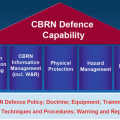© Springer Science+Business Media Dordrecht 2015
Samuel Apikyan and David Diamond (eds.)Nuclear Threats and Security ChallengesNATO Science for Peace and Security Series B: Physics and Biophysics10.1007/978-94-017-9894-5_22. Neutralizing Radicalized Threat Networks, Disrupting WMD Illicit Traffickers and Targeting Corrupt Facilitators
(1)
U.S. Department of State, National Security and Diplomacy, Anti-Crime Programs, Bureau of International Narcotics and Law Enforcement Affairs (INL), Washington, DC, USA
Abstract
Neutralizing WMD Trafficking Networks and Facilitators: Criminal networks are not only expanding their operations, but they are also diversifying their activities, resulting in a convergence of transnational threats that has evolved to become more complex, volatile, and destabilizing. These networks also threaten U.S. interests by forging alliances with corrupt elements of national governments and using the power and influence of those elements to further their criminal activities. In some cases, national governments exploit these relationships to further their interests to the detriment of the United States.
TOC threatens U.S. interests by taking advantage of failed states or contested spaces; forging alliances with corrupt foreign government officials and some foreign intelligence services; destabilizing political, financial, and security institutions in fragile states; undermining competition in world strategic markets; using cyber technologies and other methods to perpetrate sophisticated frauds; creating the potential for the transfer of weapons of mass destruction (WMD) to terrorists; and expanding narcotrafficking and human and weapons smuggling networks. Terrorists and insurgents increasingly are turning to criminal networks to generate funding and acquire logistical support.
Presentation will outline the threats posed by global illicit trafficking networks including how crime-terror pipelines can be leveraged by transnational organized crime, terrorist groups, and facilitators that provide opportunities for the successful criminal transfer of WMD material to adversaries intent on threatening the welfare and security of the United States and NATO partners.
2.1 Illicit Trafficking Networks and WMD Proliferation
We live in a time of insecurity, from deadly infectious diseases such as the Ebola virus, to the proliferation of violent terrorist networks, to the destructive consequences of climate change, and of course, transnational crime, including the horrors that can result from weapons of mass destruction. These are grave threats to our collective security.
Shortly after the September 2014 NATO Summit, held in Wales, President Barack Obama addressed the nation on the threats posed by the Islamic State of Iraq and the Levent (ISIL). The President underscored how we must continue to confront the grave threats posed by terrorism, stating:
We can’t erase every trace of evil from the world, and small groups of killers have the capacity to do great harm. That was the case before 9/11, and that remains true today. And that’s why we must remain vigilant as threats emerge.
President Obama also sent a strong message that day to all threat actors and networks around the world who wish to harm Americans and our vital national security interests that those who threaten our country and the safety of Americans will be brought to justice. He said, “This is a core principle: if you threaten America, you will find no safe haven.”
A corollary concern is the frightening reality of today’s global threat environment consisting of the potential use of chemical, biological, radiological, and nuclear weapons. In some cases, these WMD remain insufficiently safeguarded from theft or other illicit access.
There are still too many terrorists, criminals, and rogue facilitators driven to get access to these WMD; people and networks committed to unleashing these weapons upon scores of innocent people.
Past seizures of weapons-grade nuclear material indicate that such materials continue to circulate on the black market, where they can be bought by criminals and, potentially, transferred to terrorists.
The threat from nuclear terrorism is real. No country is exempt.
Over these next 3 days, distinguished scholars and participants at this conference will address related topics that are of critical importance to NATO and to the international community including the preparedness for nuclear and radiological threats.
These include developing methodologies to identify strategies to measure and reduce the potential risks of trafficking in weapons of mass destruction by illicit actors, and means, methods, and responses to detect, disrupt, and dismantle these threats before they inflict harm on our communities.
Finally, I will advance a novel proposition for the international community to ponder and perhaps begin to view some of today’s violent radicalized groups such as ISIL and al-Qaeda affiliates as agents of mass destruction themselves.
2.2 The Origins of a Threat Network
Three years ago, a start-up venture was formed overseas. Much of its early day-to-day operations were small time, simply trying to do what all other nascent businesses try to do: make a name for itself, establish funding and resources, and acquire the talent and equipment necessary to succeed.
In the years since, it has become a global leader in its field, picking up techniques that modern businesses utilize to get ahead, adapt, and leverage market opportunities. Social media and innovative marketing have played a large part of its success—using Facebook and Twitter to amplify its early messages to followers around the world, as well as enable their operations across borders.
As for resources, forget crowdfunding websites—this organization has been able to amass assets in the billions of dollars over the past 3 years. Their adept use of networks, along with some profitable acquisitions, have left them more than adequately funded to take on further expansion.
Most importantly, they are diversifying across markets and borders—they have expanded their portfolio from local affairs to large-scale natural resource management, equipment acquisition and distribution, and dealing in illicit enterprises—from oil bunkering and kidnapping to cigarette smuggling and in trafficking in antiquities.
While there have been reports of some small use of WMD, we are still monitoring plans for larger-scale attacks, as are the citizens of Iraq, Syria, and the rest of the Middle East.
This is the story of the Islamic State of Iraq and the Levant, folks. ISIL.
2.3 Agents of Mass Destruction
A merciless, ideologically-driven terrorist organization bent on creating an Islamic caliphate—from the Levant to Southeast Asia and across Africa—ISIL is in many ways the newest model of a threat network: an international organization that exports fear and exploits profitable opportunities to further its ideological and criminal goals.
Their ideology and violent acts are themselves repulsive as we saw in the litany of horrific crimes against the Yazidis in Iraq. Make no mistake, ISIL would not hesitate to maximize their propensity for further mass violence to the highest degree by unleashing a traditional WMD to murder large numbers of innocent people and continue their march of destruction.
This is why I would venture to add that, in my personal opinion, ISIL, and other terrorist groups, are agents of mass destruction that are killing innocent people, obliterating communities and holy sites, and committing mass atrocities that test the limits of our humanity, such as beheadings, crucifixions, rapes, and other forms of violence.
I do not think that is a stretch, frankly. After all, what is a “weapon of mass destruction”? For certain, when we think of WMD, we think of nuclear, biological, or chemical weapons or devices. But as we witnessed in Boston several years ago, a simple kitchen appliance, a pressure cooker, can also wreak havoc when criminally manipulated.
Suicide bombers can cause mass casualties and instill terror in communities.
Sick individuals that have contracted deadly viruses or pathogens can virtually become bioterror weapons as part of an outbreak.
Nothing today can be ruled out of the realm of possibility. If determined jihadists are willing to blow themselves up, why not do the same using a deadly virus inside their bodies to kill others through transmission?
A new day is upon us where terrorists like ISIL should be viewed as agents of mass destruction.
And ISIL is not alone.
Stay updated, free articles. Join our Telegram channel

Full access? Get Clinical Tree







